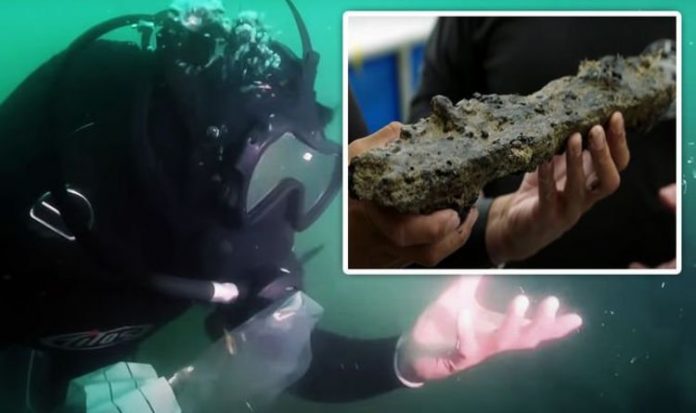The site lies east of the Isle of Wight, and the findings constitute the most intact wooden Middle Stone Age structure ever found in the UK. It is now 11 metres below sea level, but during the period there was human activity on the site, at a time before the North Sea was fully formed and the Isle of Wight was still connected to mainland Europe. National Geographic’s Albert Lin dived below the surface to take a look during its ‘Lost Cities’ documentary.
He said: “Maritime archaeologist Garry Momber has been exploring these waters for 20 years.
“The English Channel is a notoriously difficult place to dive and meticulous preparations are vital.
“With powerful tides and cold water, conditions are treacherous. But at the bottom of this line, lies a treasure trove from another age.
“8,000 years ago, sea levels were lower and the seabed was dry land.”
Archaeologists first identified the site when they spotted an arrangement of trimmed timbers that could be platforms, walkways or collapsed structures.
However, these were difficult to interpret until the Maritime Archaeological Trust used state of the art photogrammetry techniques to record the remains.
They revealed a cohesive platform consisting of split timbers, several layers thick, resting on horizontally laid round-wood foundations.
Mr Lin described what it was like to take a first-hand look at the ancient structure during the series.
He added: “Wood has survived underwater for millennia – the trees are all part of a hunter-gatherer landscape.
READ MORE: Archaeology ‘treasure trove’ exposes doomsday prophecy that ‘never made Bible’
He said in 2019: “You can see here how this piece of wood could be locked in time in the ocean.
“As the sea level has risen above it, it has covered it with this silt and it’s taken away the oxygen to preserve it.
“It would have stayed there for many more thousand years.
“But recently, the old landscape’s eroding away, which is how we found it.
“This would have been next to a stream and we know it was a bit of a wetland so it could have been a platform, but we don’t know yet as there is nothing else like it in the country.”
The most striking revelation about the platform is the technique used to construct it.
Researchers believe the construction methods used to make the platform weren’t developed until much later.
The Maritime Archaeological Trust is working with the National Oceanography Centre (NOC) to record and study, reconstruct and display the collection of timbers.
Many of the wooden artefacts are being stored in the British Ocean Sediment Core Research facility (BOSCORF), operated by the National Oceanography Centre.







